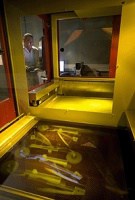The engineers at BAE Systems responsible for the components, a mix of plastic protective covers and metal support struts, said they demonstrated how 3D printing could reduce costs and increase strength compared to conventionally made parts.
The company is undertaking a programme of designing and producing 3D printed components that it claims has already cut the cost of repairs, maintenance and service to the Royal Air Force by more than £300,000 and will result in more than £1.2m of savings over the next four years.

3D printing can reduce the cost of producing small numbers of components – which is common in the aerospace industry – because it doesn’t require the creation of custom manufacturing tools.
‘This will be quite a game changer, not just for the aerospace industry but for a number of industries, producing parts in small batches,’ BAE head of airframe integration Mike Murray told The Engineer.
But, he added, the technology was improving to the point where it could eventually make 3D printing cost-competitive with some traditional mass-production processes such as injection moulding.
One of the parts – a plastic cover for a cockpit radio – cost less than £100 to manufacture and cut production time by weeks. Another – a plastic guard for a power take-off shaft – was made as a single part rather than a number of separate components. The engineers also 3D printed a stainless steel support strut for an air intake door using a Renishaw metal 3D printer as a demonstration model.
Murray said the 3D printers had no problem producing components certified for a limited number of flights but more data was needed before they were proven to be of equal quality to traditionally machined parts.
BAE Systems is also undertaking studies with Cranfield and Birmingham universities on producing large frame components to replace conventional titanium frames.





Poll: Should the UK’s railways be renationalised?
I _do_ remember British Rail - and that it was <i>literally</i> a national joke https://youtu.be/zV2lmSDKvO8